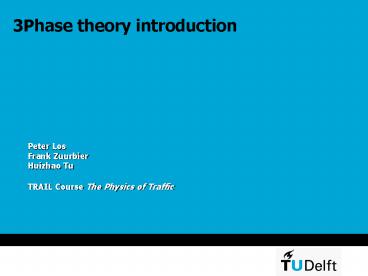3Phase theory introduction - PowerPoint PPT Presentation
1 / 17
Title:
3Phase theory introduction
Description:
... states in with a specific (unique) spatiotemporal features ... to be able observe the spatiotemporal changes. FUNDAMENTAL DIAGRAM. empirical observations ... – PowerPoint PPT presentation
Number of Views:51
Avg rating:3.0/5.0
Title: 3Phase theory introduction
1
3Phase theory introduction
Peter Los Frank Zuurbier Huizhao Tu
TRAIL Course The Physics of Traffic
2
DEFINITIONS
- Traffic variables e.g. flow (q), (vehicle) speed
(v), time/space gap (g), density (?) - Traffic (control) parameters e.g. weather, road
conditions (alignment, width, etc) vehicle
characteristics - Traffic state A state characterized by certain
set of variables and parameters - Traffic phase set of traffic states in with a
specific (unique) spatiotemporal features
3
DEFINITIONS
UPstream backwards
DOWNstream forward
IN flow
OFF flow
OUT flow
ON flow
4
DEFINITIONS
- FRONT
- a region where a spatial transition is performed
between different traffic - a) states
- b) phases
- Downstream front edge of the state forwards the
direction of traffic flow - Upstream front edge of the state backwards the
direction of traffic flow
5
DEFINITIONS
direction of traffic flow
Variable (speed, flow, etc)
distance
upstream front
downstream front
state UP
state IN
state DOWN
- width ? length !!!
6
MEASUREMENTLocal traffic variables
- by double induction loops we measure variables
- ?ti length of pulse (and pause)
- ?ti time lag between 2 loops
- ? vi , di speed length of vehicle
- ? ? , g time and distance gap
- ? macroscopic traffic flow
- q, ? and v (temporal) speed of flow???
7
MEASUREMENT
- at bottlenecks(control parameters change)
- to be able observe the spatiotemporal changes
8
FUNDAMENTAL DIAGRAMempirical observations
9
FUNDAMENTAL DIAGRAMModels
- (Deterministic) Macroscopic
- L-W-R (1955-56), Prirogine (1959)Payne (1971)
and further developments - (Deterministic) Microscopiccar following
acceleration gap - optimal velocity accel. gap speed
difference - inteligent driver accel. speed gap ?
speed - Stochastic
- Gipps (1981) safe distance
- cellular automata
10
FUNDAMENTAL DIAGRAMShock-wave theory
- Conservation of number of vehicles
- based on the particle conservation law
- Shock-wave formula ?1(v1-vp) ?2(v2-vp)
- Velocity of the shock-wave
11
FUNDAMENTAL DIAGRAM LWR model
- Lighthill Whitham (1955) and Richards (1956)
- the flow (q) is a function of the density (?)
- qq(?) i.e. only one independent variable
- Conservation balance formula
- solution Kinematic waves
12
PROBLEMS OF FD APPROACH
- it works only in homogeneous steady-states
- i.e. same distances, same time-dependent speed
- describes the free-flow well-enough
- at higher density presents only averaged
characteristics of congested patterns(not
considering noise and perturbations)
13
FUNDAMENTAL DIAGRAM 2-phase theory
- Prirogine and Herman (1971)
- concept of collective flow in FD-aproach
- 2-phase traffic flow theory
- - free flow and
- - collective flow at higher densities
- synchronization of vehicle speed (probability of
passing is a monotonous decreasing function of
density)
14
FUNDAMENTAL DIAGRAM Moving jams scenarios
- Herman et al. and KomentaniSasaki (1958-59)
- ideas of statistical physics to explain the
moving jams - instabilities (driver behaviour
over-decelaration) - critical point (density)
- KernerKornhauser (1994)
- Metastable traffic flow - below the critical
density
15
WIDE MOVING JAM
direction of traffic flow
Variable (speed, flow, etc)
distance
upstream front
downstream front
state UP
state IN
state DOWN
- WMJ width of state in gtgt width of fronts
16
FUNDAMENTAL DIAGRAMMoving jam characteristics
- J-line determined by characteristics of free
flow by accelerating from the standstill - independent parameters(only if free
outflow!)?del , qout , ?min , vmax - point j is the treshold of metastability
qmax
j
unstable
qout
J - slope vg
stablefree flow
?min
?max
17
FUNDAMENTAL DIAGRAM Metastability of free flow
- line K
- vup lt vg
- the width of jam decreases
- line N
- vup gt vg
- .the width of jam increases
n ?n qn
qmax
qout
N
K
?min
?max































